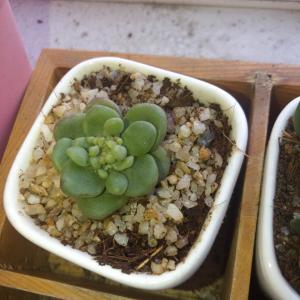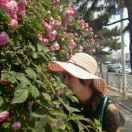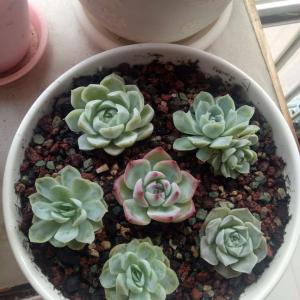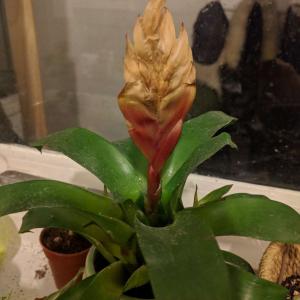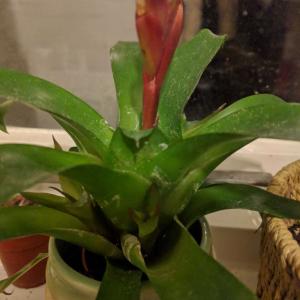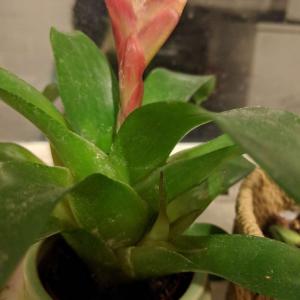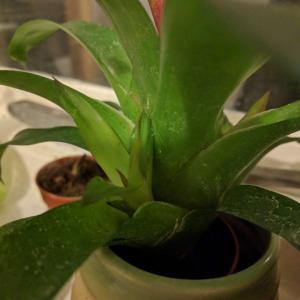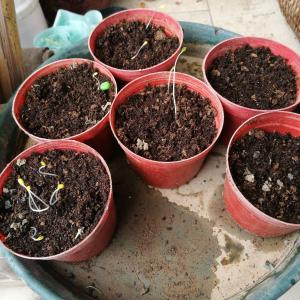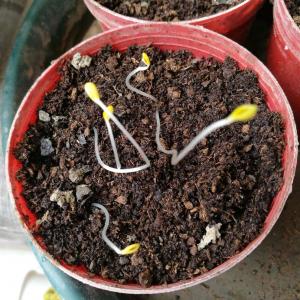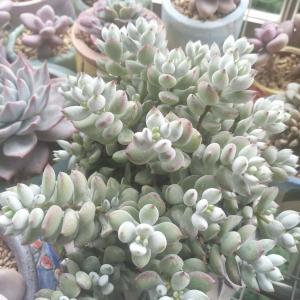文章
Miss Chen
2018年05月06日

Description: This herbaceous perennial plant develops a flowering stalk that is 3–10" tall (rarely more). The unbranched stalk is dull yellow, brown, or dark reddish purple; it is also terete, glabrous, and bulbous at the base. Closely surrounding the lower one-third of this flowering stalk, there are 2-3 leaf sheaths, but no leaf blades. These inconspicuous sheaths are the same color as the stem and glabrous. The stalk terminates in a raceme of about 5-25 flowers (rarely more); this raceme is 1–4.5" long (rarely more). The flowers are sparsely to moderately distributed along the central axis of the raceme; their faces are ascending to widely spreading while in bloom. The flowers are either chasmogamous (more showy and requiring insects for cross-pollination) or they are cleistogamous (less showy and self-fertile). Plants with chasmogamous flowers are referred to as Corallorhiza odontorhiza pringlei, while plants with cleistogamous flowers are referred to as Corallorhiza odontorhiza odontorhiza.
The chasmogamous flowers are about 6-8 mm. high and similarly across; the cleistogamous flowers are more narrow and tubular-angular in shape. Individual flowers of both types have 3 petaloid sepals (2 lateral sepals and an upper sepal), 3 petals (2 upper-lateral petals and a lower petal that is referred to as the lower lip), a small whitish reproductive column, and an ovary. All three sepals and the two upper-lateral petals are more or less oblong-elliptic in shape, whether the flowers are chasmogamous or cleistogamous; they are yellowish brown to reddish purple, becoming whitened at the base. The lower petal (or lip) of a chasmogamous flower is oval-orbicular in shape and finely crenate-undulate along its lateral and outer margins; it is predominately white with reddish purple spots. The lower petal of a cleistogamous flower is similar, except it is more narrow. For a chasmogamous flower, the upper sepal and upper-lateral petals form a protective hood over the reproductive column of the flower; the lateral sepals may form the lateral sides of the hood, or they may arch downward and spread outward slightly. The lower lip of a chasmogamous flower curves downward, functioning as a landing pad for visiting insects. A cleistogamous flower is tubular-angular in shape as a result of the sepals and petals joining together; the mouth of this flower is either slightly open or closed. The slender pedicels of the flowers are 2–3.5 mm. long, while the floral bracts directly underneath the pedicels are 2.5–4 mm. long, linear to linear-lanceolate inDistribution Map shape, and deciduous. The blooming period can occur from late summer to mid-autumn, lasting about 3 weeks. Afterwards, fertile flowers are replaced by drooping seed capsules that are 5–8.5 mm. long, broadly ellipsoid-oblongoid in shape, 6-furrowed along their sides, and glabrous. Immature capsules are light green or dull yellow (and sometimes reddish purple along their furrows), but they become brown at maturity. These capsules split open after a hard frost to release their tiny seeds to the wind. The root system consists of a mass of coralloid (coral-like) rhizomes that form contorted chunky strands about 3-5 mm. across; young rhizomes are white, while older rhizomes are brown. Older rhizomes often form buds, from which new clonal flowering stalks can develop.
Cultivation: The preference is moist to dry-mesic loam with decaying organic matter. Because this plant does not produce significant chlorophyll, it is relatively indifferent to sun exposure, although excessive dryness in the soil from too much sunlight is harmful to it. This plant requires the presence of ectomycorrhizal fungi (more specifically, Tomentilla spp.) in the soil, otherwise it can't develop properly. This orchid forms a parasitic relationship with such fungi, as the latter transports nutrients from both itself and from the trees with which they form a symbiotic relationship. The ectomycorrhizal fungi, Tomentilla spp., can form such relationships with various hardwood trees (oaks, hickories, and American Beech) and probably some conifer trees (pines). After a seed of this orchid germinates, it can flower in as little as 4 years under favorable conditions. Because of its dependence on specific ectomycorrhizal fungi, an adult plant is unlikely to survive transplantation to a different site.
Range & Habitat: Autumn Coralroot (Corallorhiza odontorhiza) occurs in scattered counties throughout Illinois; it is uncommon within the state overall. This orchid is widely distributed in the northeastern region of the United States, central-eastern region of the United States, and southern Ontario in Canada. Habitats include rich deciduous woodlands, wooded slopes, and pine plantations. This orchid is found in higher quality natural areas.
Faunal Associations: Plants with chasmogamous flowers are probably visited by bees, while plants with cleistogamous flowers don't require insect pollination. Some Coralroot orchids (Corallorhiza spp.) attract orchid weevils (Stethobaris ovata, Stethobaris commixta). As adults, these weevils feed destructively on sheaths, buds, and flowers, while their larvae feed from within the seedpods. It is not clear, however, if they feed on Fall Coralroot, as its flowering stalk doesn't develop until late in the year. Some mammals may feed on this orchid occasionally. For example, small rodents may dig holes to feed on the roots, while deer may browse on the flowering stalks. However, because the flowering stalks of this orchid are rather small and they don't stand out from the background, such browsing is probably uncommon.

Photographic Location: A deciduous woodland in Douglas County, Illinois. The photographed plant is Corallorhiza odontorhiza odontorhiza. Some of the cleistogamous flowers toward the apex of the racemes may be in bloom, while below the flowers are no longer in bloom. The latter have become immature seed capsules.
Comments: Because the flowers of this orchid in Illinois are usually cleistogamous, it is not very showy. Among the Coralroot orchids (Corallorhiza spp.), Autumn Coralroot (Corallorhiza odontorhiza) is the last species to bloom and it is also the smallest in size. When they occur, the chasmogamous flowers of this orchid can be distinguished from the flowers of other Coralroot orchids using the following criteria: 1) its flowers are smaller in overall size, 2) the lower lip of its flower is finely crenate-undulate, rather than smooth, along the margin, and 3) the lower lip of its flower lacks basal lobes (auricles). Another common name of this orchid is Fall Coralroot.
The chasmogamous flowers are about 6-8 mm. high and similarly across; the cleistogamous flowers are more narrow and tubular-angular in shape. Individual flowers of both types have 3 petaloid sepals (2 lateral sepals and an upper sepal), 3 petals (2 upper-lateral petals and a lower petal that is referred to as the lower lip), a small whitish reproductive column, and an ovary. All three sepals and the two upper-lateral petals are more or less oblong-elliptic in shape, whether the flowers are chasmogamous or cleistogamous; they are yellowish brown to reddish purple, becoming whitened at the base. The lower petal (or lip) of a chasmogamous flower is oval-orbicular in shape and finely crenate-undulate along its lateral and outer margins; it is predominately white with reddish purple spots. The lower petal of a cleistogamous flower is similar, except it is more narrow. For a chasmogamous flower, the upper sepal and upper-lateral petals form a protective hood over the reproductive column of the flower; the lateral sepals may form the lateral sides of the hood, or they may arch downward and spread outward slightly. The lower lip of a chasmogamous flower curves downward, functioning as a landing pad for visiting insects. A cleistogamous flower is tubular-angular in shape as a result of the sepals and petals joining together; the mouth of this flower is either slightly open or closed. The slender pedicels of the flowers are 2–3.5 mm. long, while the floral bracts directly underneath the pedicels are 2.5–4 mm. long, linear to linear-lanceolate inDistribution Map shape, and deciduous. The blooming period can occur from late summer to mid-autumn, lasting about 3 weeks. Afterwards, fertile flowers are replaced by drooping seed capsules that are 5–8.5 mm. long, broadly ellipsoid-oblongoid in shape, 6-furrowed along their sides, and glabrous. Immature capsules are light green or dull yellow (and sometimes reddish purple along their furrows), but they become brown at maturity. These capsules split open after a hard frost to release their tiny seeds to the wind. The root system consists of a mass of coralloid (coral-like) rhizomes that form contorted chunky strands about 3-5 mm. across; young rhizomes are white, while older rhizomes are brown. Older rhizomes often form buds, from which new clonal flowering stalks can develop.
Cultivation: The preference is moist to dry-mesic loam with decaying organic matter. Because this plant does not produce significant chlorophyll, it is relatively indifferent to sun exposure, although excessive dryness in the soil from too much sunlight is harmful to it. This plant requires the presence of ectomycorrhizal fungi (more specifically, Tomentilla spp.) in the soil, otherwise it can't develop properly. This orchid forms a parasitic relationship with such fungi, as the latter transports nutrients from both itself and from the trees with which they form a symbiotic relationship. The ectomycorrhizal fungi, Tomentilla spp., can form such relationships with various hardwood trees (oaks, hickories, and American Beech) and probably some conifer trees (pines). After a seed of this orchid germinates, it can flower in as little as 4 years under favorable conditions. Because of its dependence on specific ectomycorrhizal fungi, an adult plant is unlikely to survive transplantation to a different site.
Range & Habitat: Autumn Coralroot (Corallorhiza odontorhiza) occurs in scattered counties throughout Illinois; it is uncommon within the state overall. This orchid is widely distributed in the northeastern region of the United States, central-eastern region of the United States, and southern Ontario in Canada. Habitats include rich deciduous woodlands, wooded slopes, and pine plantations. This orchid is found in higher quality natural areas.
Faunal Associations: Plants with chasmogamous flowers are probably visited by bees, while plants with cleistogamous flowers don't require insect pollination. Some Coralroot orchids (Corallorhiza spp.) attract orchid weevils (Stethobaris ovata, Stethobaris commixta). As adults, these weevils feed destructively on sheaths, buds, and flowers, while their larvae feed from within the seedpods. It is not clear, however, if they feed on Fall Coralroot, as its flowering stalk doesn't develop until late in the year. Some mammals may feed on this orchid occasionally. For example, small rodents may dig holes to feed on the roots, while deer may browse on the flowering stalks. However, because the flowering stalks of this orchid are rather small and they don't stand out from the background, such browsing is probably uncommon.

Photographic Location: A deciduous woodland in Douglas County, Illinois. The photographed plant is Corallorhiza odontorhiza odontorhiza. Some of the cleistogamous flowers toward the apex of the racemes may be in bloom, while below the flowers are no longer in bloom. The latter have become immature seed capsules.
Comments: Because the flowers of this orchid in Illinois are usually cleistogamous, it is not very showy. Among the Coralroot orchids (Corallorhiza spp.), Autumn Coralroot (Corallorhiza odontorhiza) is the last species to bloom and it is also the smallest in size. When they occur, the chasmogamous flowers of this orchid can be distinguished from the flowers of other Coralroot orchids using the following criteria: 1) its flowers are smaller in overall size, 2) the lower lip of its flower is finely crenate-undulate, rather than smooth, along the margin, and 3) the lower lip of its flower lacks basal lobes (auricles). Another common name of this orchid is Fall Coralroot.
0
0
文章
Miss Chen
2018年05月06日

Description: This herbaceous perennial plant is 3-8" tall and unbranched. It consists of a rather thick spike of flowers, while the leaves are reduced to scales. During the late spring this spike is cream-colored and hairless. Underneath each flower, there is an ovate scale up to ½" long that quickly turns brown. The flowers bloom during the late spring or early summer for about 3 weeks. They are densely crowded all around the spike, and begin to bloom from the bottom to the top. Each flower is about ½" long, consisting of a tubular corolla and a tubular calyx. Both the corolla and calyx are cream-colored, although the teeth of the calyx soon turn brown and wither away. The rest of the calyx wraps around the base of the corolla. The corollas of young flowers are initially semi-erect, but they spread outward from the spike with age. Each corolla has a convex upper lip that functions as a hood, while the poorly defined lower lip is smaller in size. Within the corolla, there are 4 stamens near the interior of the upper lip, and a single stout style that develops along the lower lip. Both the style and filaments of the stamens are white, while the anthers are grey. When the flowers are blooming, some of the stamens and styles may be exerted from their corolla tubes. There is no noticeable floral scent. Each flower is replaced by a seed capsule containing many small seeds; this seed capsule is longer than it is wide.
As the summer progresses, the flowering spike begins to wither and becomes brown. It can persist through the winter, by which time it has become shriveled and black. The root system is parasitic on the roots of Quercus spp. (Oak Trees); the suckers of the parasitic roots cause the formation of large rounded knobs on the roots of the host tree. Because Cancer Root doesn't produce chlorophyll, it is dependent on the host tree for its nourishment. Small clusters of flowering spikes often develop from the same root system. This plant spreads to new locations by reseeding itself.
Cultivation: This parasitic plant is indifferent to light levels. It requires the presence of an Oak tree or its saplings at a well-drained site where the soil is not too compacted.
Range & Habitat: The native Cancer Root is an uncommon plant that has been observed in central and NE Illinois in several counties (see Distribution Map). Habitats include upland woodlands, bluffs, wooded slopes and ravines, and savannas. In all of these habitats, Quercus spp. (Oaks) are invariably present. The flowering spikes of Cancer Root often develop in areas where the leaf litter is scant. The greatest threat to local populations is the invasion of Acer saccharum (Sugar Maple) in Oak woodlands as a result of fire suppression.

Faunal Associations: The pollinators of the flowers have not been described for this species to my knowledge. A related species, Orobanche uniflora (One-Flowered Broomrape), is pollinated by bumblebees. Black Bears forage on the flowering spikes of Cancer Root after they come out of hibernation. There is also some evidence that deer browse on the flowering spikes occasionally. Because it is possible that the seeds can survive passage through the gastrointestinal tract, such animals may help to disperse the seeds to new locations.
Photographic Location: A bluff in Vermilion County, Illinois.
Comments: This parasitic plant looks like a mutant pine cone or something from a horror movie. Its closest relatives are Orobanche spp. (Broomrapes), which are also parasitic and uncommon. The species Orobanche ludoviciana (Prairie Broomrape) has a similar appearance with thick white spikes of flowers, but the corollas of its flowers are usually tinted lavender or pale purple and they are longer (about ¾" in length). Another common name of Conopholis americana is Squawroot.
As the summer progresses, the flowering spike begins to wither and becomes brown. It can persist through the winter, by which time it has become shriveled and black. The root system is parasitic on the roots of Quercus spp. (Oak Trees); the suckers of the parasitic roots cause the formation of large rounded knobs on the roots of the host tree. Because Cancer Root doesn't produce chlorophyll, it is dependent on the host tree for its nourishment. Small clusters of flowering spikes often develop from the same root system. This plant spreads to new locations by reseeding itself.
Cultivation: This parasitic plant is indifferent to light levels. It requires the presence of an Oak tree or its saplings at a well-drained site where the soil is not too compacted.
Range & Habitat: The native Cancer Root is an uncommon plant that has been observed in central and NE Illinois in several counties (see Distribution Map). Habitats include upland woodlands, bluffs, wooded slopes and ravines, and savannas. In all of these habitats, Quercus spp. (Oaks) are invariably present. The flowering spikes of Cancer Root often develop in areas where the leaf litter is scant. The greatest threat to local populations is the invasion of Acer saccharum (Sugar Maple) in Oak woodlands as a result of fire suppression.

Faunal Associations: The pollinators of the flowers have not been described for this species to my knowledge. A related species, Orobanche uniflora (One-Flowered Broomrape), is pollinated by bumblebees. Black Bears forage on the flowering spikes of Cancer Root after they come out of hibernation. There is also some evidence that deer browse on the flowering spikes occasionally. Because it is possible that the seeds can survive passage through the gastrointestinal tract, such animals may help to disperse the seeds to new locations.
Photographic Location: A bluff in Vermilion County, Illinois.
Comments: This parasitic plant looks like a mutant pine cone or something from a horror movie. Its closest relatives are Orobanche spp. (Broomrapes), which are also parasitic and uncommon. The species Orobanche ludoviciana (Prairie Broomrape) has a similar appearance with thick white spikes of flowers, but the corollas of its flowers are usually tinted lavender or pale purple and they are longer (about ¾" in length). Another common name of Conopholis americana is Squawroot.
0
0
文章
Miss Chen
2018年05月06日

Description: This perennial wildflower is about 3-6" tall, consisting of a flowering stem with a pair of opposite cauline leaves and some basal leaves. The stem is light green or slightly reddish green, glabrous, and rather succulent. The basal leaves and the pair of cauline leaves are linear or linear-lanceolate, slightly recurved, glabrous, smooth along the margins, and slightly fleshy. There is a single central vein along the length of each leaf. The leaves are about 2-5" long; their width varies somewhat depending on the local ecotype, but it is usually about ¼" across. The stem terminates in a floppy raceme of flowers. Each flower is about 8 mm. (1/3") across when it is fully open, consisting of 5 petals, 2 green sepals, 5 stamens with pink anthers, and a pistil with a tripartite style. The petals are white with fine pink stripes; these stripes vary from pale pink to bright pink. The flowers open up on warm sunny days, and close during cloudy weather or at night. They are more or less erect while open, but nod downward while closed. The blooming period occurs from mid- to late spring and lasts about 1-2 months. There is a pleasant floral scent. Each fertile flower produces an ovoid capsule containing several seeds; this capsule is enclosed by the 2 persistant sepals. The root system consists of a small corm and secondary roots. This wildflower spreads by reseeding itself; sometimes it forms rather loose colonies of plants.
Cultivation: The preference is dappled sunlight during the spring, moist to slightly dry conditions, and a rich loamy soil with abundant organic matter. This wildflower will adapt to semi-shaded areas of lawns if mowing is delayed during the spring. Both the flowers and foliage fade away by mid-summer. The easy way to start plants is by obtaining their corms, although these are expensive to buy from nurseries.
Range & Habitat: The native Spring Beauty is a common wildflower that occurs in every county of Illinois (see Distribution Map). Habitats include moist to dry deciduous woodlands, savannas, thinly wooded bluffs, city parks, old cemeteries, and lawns (particularly near trees). Less often, this species is found in mesic prairies, but it is primarily a woodland plant. Spring Beauty can survive more environmental degradation than most spring-blooming woodland species, including occasional grazing by cattle and partial clearing of trees. This is one reason why it is still common.

Faunal Association: Aside from insect pollination, little is known about floral-faunal relationships. Various kinds of bees visit the flowers, include honey bees, bumblebees, little carpenter bees (Ceratina spp.), mason bees (Osmia spp.), cuckoo bees (Nomada spp.), Halictid bees (Agapostemon spp., Augochlorella spp., Halictus spp., Lasioglossum spp.), and Andrenid bees (Andrena spp.). An Andrenid bee, Andrena erigeniae, is a specialist pollinator of Spring Beauty. Many flies also visit the flowers, including Syrphid flies, the Giant Bee fly (Bombylius major), flesh flies (Sarcophagidae), and Calliphorid flies. Less often, various butterflies and skippers visit the flowers. These insects usually seek nectar, although some of the bees also collect pollen. The corms of Spring Beauty are dug up and eaten by some small rodents, including the White-Footed Mouse and Eastern Chipmunk (Martin et al., 1951/1961; Wrazen & Svendsen, 1978). The foliage is browsed sparingly by White-Tailed Deer (Augustine, 1997). While the corms of Spring Beauty can be eaten by humans as well, their small size makes this rather impractical.

Photographic Location: Busey Woods and an old cemetery in Urbana, Illinois.
Comments: This attractive wildflower is a sure sign that spring has arrived and that the local woodlands are full of wildflowers. When Spring Beauty and these other wildflowers are conspicuously absent from a woodlands, this indicates that it has been subjected to severe degradation from plows or bulldozers at some point in the past. In Illinois, Spring Beauty is a unique member of the Purslane family that is easy to distinguish from other wildflowers. Look for pink-stripes, whether pale or bright, on the petals of the flowers, and only 2 sepals underneath. In southeastern and other parts of the United States, there is a closely related wildflower, Claytonia carolina (Carolina Beauty). This latter species has a similar appearance to Spring Beauty, but it doesn't occur in Illinois. The leaves of Carolina Beauty are usually broader than those of Spring Beauty.
Cultivation: The preference is dappled sunlight during the spring, moist to slightly dry conditions, and a rich loamy soil with abundant organic matter. This wildflower will adapt to semi-shaded areas of lawns if mowing is delayed during the spring. Both the flowers and foliage fade away by mid-summer. The easy way to start plants is by obtaining their corms, although these are expensive to buy from nurseries.
Range & Habitat: The native Spring Beauty is a common wildflower that occurs in every county of Illinois (see Distribution Map). Habitats include moist to dry deciduous woodlands, savannas, thinly wooded bluffs, city parks, old cemeteries, and lawns (particularly near trees). Less often, this species is found in mesic prairies, but it is primarily a woodland plant. Spring Beauty can survive more environmental degradation than most spring-blooming woodland species, including occasional grazing by cattle and partial clearing of trees. This is one reason why it is still common.

Faunal Association: Aside from insect pollination, little is known about floral-faunal relationships. Various kinds of bees visit the flowers, include honey bees, bumblebees, little carpenter bees (Ceratina spp.), mason bees (Osmia spp.), cuckoo bees (Nomada spp.), Halictid bees (Agapostemon spp., Augochlorella spp., Halictus spp., Lasioglossum spp.), and Andrenid bees (Andrena spp.). An Andrenid bee, Andrena erigeniae, is a specialist pollinator of Spring Beauty. Many flies also visit the flowers, including Syrphid flies, the Giant Bee fly (Bombylius major), flesh flies (Sarcophagidae), and Calliphorid flies. Less often, various butterflies and skippers visit the flowers. These insects usually seek nectar, although some of the bees also collect pollen. The corms of Spring Beauty are dug up and eaten by some small rodents, including the White-Footed Mouse and Eastern Chipmunk (Martin et al., 1951/1961; Wrazen & Svendsen, 1978). The foliage is browsed sparingly by White-Tailed Deer (Augustine, 1997). While the corms of Spring Beauty can be eaten by humans as well, their small size makes this rather impractical.

Photographic Location: Busey Woods and an old cemetery in Urbana, Illinois.
Comments: This attractive wildflower is a sure sign that spring has arrived and that the local woodlands are full of wildflowers. When Spring Beauty and these other wildflowers are conspicuously absent from a woodlands, this indicates that it has been subjected to severe degradation from plows or bulldozers at some point in the past. In Illinois, Spring Beauty is a unique member of the Purslane family that is easy to distinguish from other wildflowers. Look for pink-stripes, whether pale or bright, on the petals of the flowers, and only 2 sepals underneath. In southeastern and other parts of the United States, there is a closely related wildflower, Claytonia carolina (Carolina Beauty). This latter species has a similar appearance to Spring Beauty, but it doesn't occur in Illinois. The leaves of Carolina Beauty are usually broader than those of Spring Beauty.
1
0
文章
Miss Chen
2018年05月05日

Description: This perennial plant is about ¾-2' tall and unbranched or little branched. Scattered white hairs occur occasionally along the central stem, although it becomes glabrous with age. The opposite leaves are up to 5" long and 3" across (excluding the petioles); they are ovate-cordate, dentate along their margins, and largely hairless. The upper leaf surface is medium to dark green and hairless. The slender petioles of the leaves are up to 1½" long and medium green. The central stem terminates in a raceme of flowers up to 6" long. The stalk of this raceme has scattered white hairs. The small flowers are sparsely, but evenly, distributed along this stalk on slender pedicels up to ½" long. These pedicels spread outward.
Each flower consists of 2 white petals, 2 green sepals, 2 stamens, and a slender style. Each petal is deeply divided into 2 lobes. At the base of each flower, there is a 2-celled ovary that is green and covered with stiff hooked hairs; it is obovoid in shape. Each cell of this ovary contains a single seed. The blooming period for a colony of plants occurs during the summer and lasts about a month. Each flower is short-lived and replaced by a small bur-like fruit (see the description of the ovary above). The root system can produce rhizomes or stolons that extend through the soil or leaf mould to create clonal offsets from the mother plant.
Cultivation: The preference is dappled sunlight to medium shade, more or less mesic conditions, and a rich loamy soil with abundant organic matter.

Range & Habitat: The native Enchanter's Nightshade is an occasional to locally common plant that occurs in most counties of Illinois (see Distribution Map). This plant may be less abundant than in the past because of browsing by deer. Habitats include mesic deciduous woodlands, including oak woodlands and maple/basswood woodlands, and areas that are adjacent to woodland paths. Sometimes this species occurs in wooded upland areas and along ravine slopes.
Faunal Associations: The nectar and pollen of the flowers attract small bees, including Halictid bees (Lasioglossum spp.) and little carpenter bees (Ceratina spp.); they are also visited by Syrphid flies and bee flies (Bombyliidae). The caterpillars of a moth, Mompha terminella (Enchanter's Cosmet), are blotch leaf-miners. Birds and mammals help to distribute the seeds, as the small bur-like fruits can cling to feathers and fur; these fruits can cling to the clothing of humans as well. Deer occasionally browse on the foliage of Enchanter's Nightshade.

Photographic Location: A mesic deciduous woodlands at Busey Woods in Urbana, Illinois.
Comments: This is one of the woodland wildflowers that blooms during the summer in shaded areas. The flowers of such species are usually small, white, and not very showy. Enchanter's Nightshade is a rather odd member of the Evening Primrose family, as its flowers have only 2 petals, 2 sepals, and 2 stamens. This is a distinctive characteristic of the Circaea genus in this family. The only other member of this genus that occurs in Illinois, Circaea alpina (Small Enchanter's Nightshade), is an uncommon species that is restricted to the cool moist woodlands of northern Illinois. It has leaves that are more cordate and indented at the base, and its flowers are clustered toward the apex of the flowering stalk (rather than being evenly distributed along this stalk). While Enchanter's Nightshade is ¾-2' tall and it has 2-celled ovaries, Small Enchanter's Nightshade is less than 1' tall and it has 1-celled ovaries.
Each flower consists of 2 white petals, 2 green sepals, 2 stamens, and a slender style. Each petal is deeply divided into 2 lobes. At the base of each flower, there is a 2-celled ovary that is green and covered with stiff hooked hairs; it is obovoid in shape. Each cell of this ovary contains a single seed. The blooming period for a colony of plants occurs during the summer and lasts about a month. Each flower is short-lived and replaced by a small bur-like fruit (see the description of the ovary above). The root system can produce rhizomes or stolons that extend through the soil or leaf mould to create clonal offsets from the mother plant.
Cultivation: The preference is dappled sunlight to medium shade, more or less mesic conditions, and a rich loamy soil with abundant organic matter.

Range & Habitat: The native Enchanter's Nightshade is an occasional to locally common plant that occurs in most counties of Illinois (see Distribution Map). This plant may be less abundant than in the past because of browsing by deer. Habitats include mesic deciduous woodlands, including oak woodlands and maple/basswood woodlands, and areas that are adjacent to woodland paths. Sometimes this species occurs in wooded upland areas and along ravine slopes.
Faunal Associations: The nectar and pollen of the flowers attract small bees, including Halictid bees (Lasioglossum spp.) and little carpenter bees (Ceratina spp.); they are also visited by Syrphid flies and bee flies (Bombyliidae). The caterpillars of a moth, Mompha terminella (Enchanter's Cosmet), are blotch leaf-miners. Birds and mammals help to distribute the seeds, as the small bur-like fruits can cling to feathers and fur; these fruits can cling to the clothing of humans as well. Deer occasionally browse on the foliage of Enchanter's Nightshade.

Photographic Location: A mesic deciduous woodlands at Busey Woods in Urbana, Illinois.
Comments: This is one of the woodland wildflowers that blooms during the summer in shaded areas. The flowers of such species are usually small, white, and not very showy. Enchanter's Nightshade is a rather odd member of the Evening Primrose family, as its flowers have only 2 petals, 2 sepals, and 2 stamens. This is a distinctive characteristic of the Circaea genus in this family. The only other member of this genus that occurs in Illinois, Circaea alpina (Small Enchanter's Nightshade), is an uncommon species that is restricted to the cool moist woodlands of northern Illinois. It has leaves that are more cordate and indented at the base, and its flowers are clustered toward the apex of the flowering stalk (rather than being evenly distributed along this stalk). While Enchanter's Nightshade is ¾-2' tall and it has 2-celled ovaries, Small Enchanter's Nightshade is less than 1' tall and it has 1-celled ovaries.
0
0
文章
Miss Chen
2018年05月05日

Description: This herbaceous perennial wildflower is 3-7' tall. The stems are light green and hairless, while the large compound leaves are bipinnate or tripinnate with 10 or more leaflets. Usually 3 or 5 leaflets are grouped together in the ultimate partitions of each compound leaf. Individual leaflets are up to 4" long and 3" across; they are medium green, glabrous, and lanceolate to broadly ovate in shape. The margins of these leaflets are coarsely toothed; the terminal leaflets are often shallowly to deeply cleft.
Each plant produces one or more panicles of racemes about 1-3' long. These panicles are very narrow and produce only a few secondary racemes around the central raceme. The racemes are narrowly cylindrical in shape and erect; they are densely covered with flowers, buds, and fruits (follicles) in varying stages of development (buds on top, flowers in the middle, and fruits below). Individual flowers span about 2/3" across and they are completely white, consisting of about 24 stamens, a single pistil, and insignificant sepals that drop early. The slender stamens are long and conspicuous, while the pistil has a short curved tip. Each flower has a short pedicel. The blooming period occurs during early to middle summer and lasts about 1½ months. The flowers have an odd unpleasant scent. Each flower is replaced by a small follicle about 1/3" long; this follicle hasDistribution Map a beak that is very short and usually curved. Each follicle splits open along one side to release several seeds; these seeds are fairly smooth (not conspicuously scaly). The root system is rhizomatous and fibrous.
Cultivation: The preference is partial sun to medium shade, mesic conditions, and a rich loamy soil with abundant organic material. This plant requires plenty of space.
Range & Habitat: The native Black Cohosh is rare in Illinois and state-listed as 'endangered.' It has been found in only a few counties in northern and southern Illinois. At some of these localities, Black Cohosh is probably extirpated because it hasn't observed since the late 19th century. At other localities, the population consists of plants that have been introduced. Habitat includes mesic deciduous woodlands (where Sugar Maple is often dominant) and the bases of bluffs along rivers. In Illinois, Black Cohosh is more common in flower gardens than the wild; it is also more common in natural areas further to the east, including the Appalachian mountains.
Faunal Associations: The flowers provide both nectar and pollen to insect visitors. Unfortunately, these insects are largely unknown, in part because Black Cohosh is uncommon in Illinois and neighboring states. The caterpillars of the butterfly Celastrina neglecta major (Appalachian Azure) feed exclusively on Black Cohosh; however, this insect doesn't occur in Illinois. It is doubtful that mammalian herbivores feed on this wildflower to any significant degree because the foliage is toxic.
Photographic Location: A flower garden at The Arboretum in Urbana, Illinois.
Comments: This is one of the largest woodland wildflowers. Black Cohosh is attractive as a wildflower in part because it produces showy spikes of white flowers during the summer, when there is little else in bloom in wooded habitats. For this reason, it's a pity that this species isn't more common within the state. There are two other species that Black Cohosh can be confused with. One of them, Cimicifuga rubifolia (Appalachian Bugbane), has leaflets up to 10" long and across that often display a maple-leaf shape; it also has fewer than 10 leaflets per compound leaf.

In contrast, Black Cohosh has smaller leaflets (up to 4" long and 3" across) and there are usually more than 10-20 leaflets per compound leaf. Another species, Cimicifuga americana (American Bugbane), has foliage that is nearly identical to that of Black Cohosh. However, American Bugbane has several pistils in the center of each flower, while Black Cohosh has only a single pistil per flower. Similarly, American Bugbane produces its follicles in clusters (one for each pistil), while Black Cohosh produces its follicles individually.
Each plant produces one or more panicles of racemes about 1-3' long. These panicles are very narrow and produce only a few secondary racemes around the central raceme. The racemes are narrowly cylindrical in shape and erect; they are densely covered with flowers, buds, and fruits (follicles) in varying stages of development (buds on top, flowers in the middle, and fruits below). Individual flowers span about 2/3" across and they are completely white, consisting of about 24 stamens, a single pistil, and insignificant sepals that drop early. The slender stamens are long and conspicuous, while the pistil has a short curved tip. Each flower has a short pedicel. The blooming period occurs during early to middle summer and lasts about 1½ months. The flowers have an odd unpleasant scent. Each flower is replaced by a small follicle about 1/3" long; this follicle hasDistribution Map a beak that is very short and usually curved. Each follicle splits open along one side to release several seeds; these seeds are fairly smooth (not conspicuously scaly). The root system is rhizomatous and fibrous.
Cultivation: The preference is partial sun to medium shade, mesic conditions, and a rich loamy soil with abundant organic material. This plant requires plenty of space.
Range & Habitat: The native Black Cohosh is rare in Illinois and state-listed as 'endangered.' It has been found in only a few counties in northern and southern Illinois. At some of these localities, Black Cohosh is probably extirpated because it hasn't observed since the late 19th century. At other localities, the population consists of plants that have been introduced. Habitat includes mesic deciduous woodlands (where Sugar Maple is often dominant) and the bases of bluffs along rivers. In Illinois, Black Cohosh is more common in flower gardens than the wild; it is also more common in natural areas further to the east, including the Appalachian mountains.
Faunal Associations: The flowers provide both nectar and pollen to insect visitors. Unfortunately, these insects are largely unknown, in part because Black Cohosh is uncommon in Illinois and neighboring states. The caterpillars of the butterfly Celastrina neglecta major (Appalachian Azure) feed exclusively on Black Cohosh; however, this insect doesn't occur in Illinois. It is doubtful that mammalian herbivores feed on this wildflower to any significant degree because the foliage is toxic.
Photographic Location: A flower garden at The Arboretum in Urbana, Illinois.
Comments: This is one of the largest woodland wildflowers. Black Cohosh is attractive as a wildflower in part because it produces showy spikes of white flowers during the summer, when there is little else in bloom in wooded habitats. For this reason, it's a pity that this species isn't more common within the state. There are two other species that Black Cohosh can be confused with. One of them, Cimicifuga rubifolia (Appalachian Bugbane), has leaflets up to 10" long and across that often display a maple-leaf shape; it also has fewer than 10 leaflets per compound leaf.

In contrast, Black Cohosh has smaller leaflets (up to 4" long and 3" across) and there are usually more than 10-20 leaflets per compound leaf. Another species, Cimicifuga americana (American Bugbane), has foliage that is nearly identical to that of Black Cohosh. However, American Bugbane has several pistils in the center of each flower, while Black Cohosh has only a single pistil per flower. Similarly, American Bugbane produces its follicles in clusters (one for each pistil), while Black Cohosh produces its follicles individually.
0
0
文章
Miss Chen
2018年05月05日

Description: This wildflower has evergreen leaves and semi-woody stems. The entire plant, including the inflorescence, is about 6-10" tall. Plants without an inflorescence are only 3-5" tall. The central stem of each plant is red to brown, unbranched, glabrous, and more or less terete. One or two pairs of smaller opposite leaves occur near the base of the stem, while a single whorl of three larger leaves occur at the base of the inflorescence. The leaves are 1-3" long, ¼–1" across, rather leathery in texture, and glabrous; they are lanceolate to ovate in shape, while their margins have widely spaced dentate teeth. The upper leave surface is dark green, except in areas along the veins, where it is white; this provides the upper leaf surface with a pinnately striped appearance. The lower leaf surface is light green. The petioles of these leaves are short and slender. On fertile plants, the stem terminates in an inflorescence consisting of a nodding umbel, or nodding umbel-like cyme, of 2-5 flowers on a long unbranched peduncle (flowering stalk). Sometimes the inflorescence produces only a single nodding flower. The erect peduncle is pinkish red to light brown, relatively stout, terete, and short-pubescent; the pedicels of individual flowers are similar, except they are shorter (about 1" long) and strongly recurved, holding the flowers face-down. Each flower is about ½–¾" across, consisting of 5 white petals, 5 light green sepals, 10 stamens, and a green pistil. The petals are oval in shape and concave toward the face of the flower. The sepals are oval-ovate in shape and less than one-half of the length of the petals. The stamens have showy light pink anthers and very short filaments; the anthers are bifurcated, releasing pollen from round pores at their tips. The pistil consists of a superior ovary, a short style, and large stigma (all green). The ovary is subgloboid in shape and slightly 5-lobed. The style has a short obconic shape with a broad flat tip and even broader base. The stigma is dome-shaped and wider than the style.
The blooming period occurs from late spring to early summer, lasting about 2 weeks. The flowers are fragrant. Afterwards, the flowers are replaced by seed capsules that are about 8 mm. (1/3") across and dark brown at maturity; they have the same shape as the ovary. The sepals persist underneath these seed capsules. When these capsules split open from above, they release many fine seeds. The root system consists of brown fibrous roots and underground white stolons; the latter are long and slender. Clonal plants are often produced from the stolons.
Cultivation: The preference is partial sun to medium shade, dry-mesic conditions, and an acidic soil containing some rocky material or sand. Growth and development are relatively slow. The seeds are difficult to germinate, although new plants can be created by dividing the root systems of older plants. In order to flourish, however, the presence of an appropriate mycorrhizal fungus in the soil may be required.
Range & Habitat: Striped Wintergreen is a rare native plant in Illinois, where it is state-listed as 'endangered.' It has been found in only two counties (Cook County and Pope County) within the state; see the Distribution Map. At the present time, it may be extirpated from Cook County because of development. Illinois lies along the NE range-limit of this plant; it is more common in mountainous areas further to the east and southeast. In Illinois, habitats consist of rocky upland woodlands and sandy upland woodlands; the latter habitat occurs along Lake Michigan. In these habitats, oaks (Quercus spp.) are usually the dominant canopy trees. Outside of Illinois, this plant is often found in mixed woodlands and coniferous woodlands. Striped Wintergreen is restricted to high quality natural areas in Illinois.

Faunal Associations: The flowers are cross-pollinated primarily by bumblebees; honeybees also visit the flowers (Standley et al., 1988). These insects obtain nectar from the flowers. The foliage of Striped Wintergreen is regarded as toxic to sheep (Schaffer, 1904), and White-tailed Deer usually avoid it when there are better sources of food (Rawinski, 2016).
Photographic Location: A wooded area in the southern Appalachian mountains. The photographs were taken by Paul Showers (Copyright © 2016).
Comments: Both the foliage and flowers are quite ornamental. In Illinois, the closest relative of Striped Wintergreen is Pipsissewa (Chimaphila umbellata). This latter plant can be distinguished by its leaves: 1) they are oblanceolate in shape, 2) the margins of its leaves are more finely and abundantly toothed, and 3) its leaves lack the white markings that are found on the leaves of Striped Wintergreen. The inflorescence of Pipsissewa also tends to have more flowers (4-8) than the inflorescence of Striped Wintergreen. The common name, 'Wintergreen,' refers to the evergreen leaves, as the leaves of Striped Wintergreen do not possess a mint-like fragrance. Thus, Striped Wintergreen should not be confused with another low-growing semi-woody plant, Wintergreen (Gaultheria procumbens). In addition to the fragrance of its leaves, this latter plant differs by its white bell-shaped flowers, red berries, and toothless leaf margins. Other common names of Chimaphila maculata are Spotted Wintergreen, Spotted Prince's Cone, Striped Prince's Cone, Spotted Pipsissewa, and Striped Pipsissewa.
The blooming period occurs from late spring to early summer, lasting about 2 weeks. The flowers are fragrant. Afterwards, the flowers are replaced by seed capsules that are about 8 mm. (1/3") across and dark brown at maturity; they have the same shape as the ovary. The sepals persist underneath these seed capsules. When these capsules split open from above, they release many fine seeds. The root system consists of brown fibrous roots and underground white stolons; the latter are long and slender. Clonal plants are often produced from the stolons.
Cultivation: The preference is partial sun to medium shade, dry-mesic conditions, and an acidic soil containing some rocky material or sand. Growth and development are relatively slow. The seeds are difficult to germinate, although new plants can be created by dividing the root systems of older plants. In order to flourish, however, the presence of an appropriate mycorrhizal fungus in the soil may be required.
Range & Habitat: Striped Wintergreen is a rare native plant in Illinois, where it is state-listed as 'endangered.' It has been found in only two counties (Cook County and Pope County) within the state; see the Distribution Map. At the present time, it may be extirpated from Cook County because of development. Illinois lies along the NE range-limit of this plant; it is more common in mountainous areas further to the east and southeast. In Illinois, habitats consist of rocky upland woodlands and sandy upland woodlands; the latter habitat occurs along Lake Michigan. In these habitats, oaks (Quercus spp.) are usually the dominant canopy trees. Outside of Illinois, this plant is often found in mixed woodlands and coniferous woodlands. Striped Wintergreen is restricted to high quality natural areas in Illinois.

Faunal Associations: The flowers are cross-pollinated primarily by bumblebees; honeybees also visit the flowers (Standley et al., 1988). These insects obtain nectar from the flowers. The foliage of Striped Wintergreen is regarded as toxic to sheep (Schaffer, 1904), and White-tailed Deer usually avoid it when there are better sources of food (Rawinski, 2016).
Photographic Location: A wooded area in the southern Appalachian mountains. The photographs were taken by Paul Showers (Copyright © 2016).
Comments: Both the foliage and flowers are quite ornamental. In Illinois, the closest relative of Striped Wintergreen is Pipsissewa (Chimaphila umbellata). This latter plant can be distinguished by its leaves: 1) they are oblanceolate in shape, 2) the margins of its leaves are more finely and abundantly toothed, and 3) its leaves lack the white markings that are found on the leaves of Striped Wintergreen. The inflorescence of Pipsissewa also tends to have more flowers (4-8) than the inflorescence of Striped Wintergreen. The common name, 'Wintergreen,' refers to the evergreen leaves, as the leaves of Striped Wintergreen do not possess a mint-like fragrance. Thus, Striped Wintergreen should not be confused with another low-growing semi-woody plant, Wintergreen (Gaultheria procumbens). In addition to the fragrance of its leaves, this latter plant differs by its white bell-shaped flowers, red berries, and toothless leaf margins. Other common names of Chimaphila maculata are Spotted Wintergreen, Spotted Prince's Cone, Striped Prince's Cone, Spotted Pipsissewa, and Striped Pipsissewa.
1
0
文章
Miss Chen
2018年05月05日

Description: This perennial wildflower is 1-3' tall and unbranched. The erect central stem is light green to pale purple, terete, glabrous, and often glaucous. A non-flowering plant has a single compound leaf at the apex of this stem, while a flowering plant has two compound leaves. The lower compound leaf of a flowering plant is located toward the middle of the central stem, where it is divided into a whorl of 3 compound leaflets. Each compound leaflet is ternately divided into 9 simple subleaflets that are arranged in groups of 3 (2 lateral groups and a terminal group). Less often, a compound leaflet may be divided into 15 simple subleaflets that consist of 2 additional lateral groups. The basal stalks (petiolules) of the compound leaflets are long and ascending; they are light green and glabrous. The subleaflets are 1-3" long and ¾-2" across (or occasionally wider); they are broadly ovate-oblong to obovate-oblong in shape and smooth along their margins, terminating in 2-5 cleft lobes with blunt tips. The upper surface of the subleaflets is glabrous and either gray-green, yellowish green, or medium green, while the lower surface is pale green and glabrous. The slender basal stalklets of the subleaflets are light green and glabrous. The upper compound leaf of a flowering plant is located under the inflorescence. This compound leaf resembles the lower compound leaf, except its 3 compound leaflets are smaller in size because they have only 3 subleaflets each.
On a flowering plant, the central stem terminates in a floral panicle about 1-3" long that is rounded or elongated; each panicle usually has 5-30 flowers (rarely more). Individual flowers are about 1/3" (8 mm.) across, consisting of 6 petaloid sepals, insignificant petals, 6 stamens, and an ovoid ovary with a beak-like style. Depending on the local ecotype, the oblanceolate sepals are greenish yellow, greenish brown, or greenish purple. Underneath each flower, there are 3-4 green bractlets that resemble sepals. The branching stalks of the panicle are light green, glabrous, and ascending. The blooming period occurs from mid- to late spring before the leaves have fully developed. Afterwards, the flowers are replaced by berry-like seeds that are about 1/3" across, globoid in shape, glabrous, and glaucous. These seeds are initially green, but they later become bright blue at maturity during the summer. The seed coat is fleshy and contains carbohydrates. The root system is rhizomatous and fibrous.
Cultivation: The preference is dappled sunlight during the spring, followed by light shade during the summer, at a location that has average moisture levels and fertile loamy soil. The soil should also contain abundant organic matter from decaying leaves and other plant materials, as typically occurs underneath trees. The large seeds are difficult to germinate. However, once it becomes established at a favorable site, Blue Cohosh is long-lived.
Range & Habitat: The native Blue Cohosh occurs occasionally in central Illinois, northern Illinois, and the Shawnee Hills of southern Illinois. In other areas of southern Illinois, this wildflower is uncommon or absent. Habitats include rich mesic woodlands, bluffs, and wooded slopes of large ravines. This relatively conservative wildflower can be found in woodlands dominated by either oaks or maples where the native ground flora is still intact.
Faunal Associations: Both pollen and nectar are available as floral rewards to insect visitors. These visitors include miscellaneous flies (Syrphid, Tachinid, Muscid, etc.), parasitoid wasps (Braconid, Ichneumonid, etc.), small Halictid bees (Lasioglossum spp., etc.), and bumblebees (Robertson, 1929; Hannan & Prucher, 1996). Apparently, very few insects feed destructively on the foliage and other parts of Blue Cohosh. Caterpillars of the moth Clepsis melaleucana (Black-Patched Clepsis) and the plant bug Metriorrhynchomiris dislocatus have been observed to feed on this plant (Covell, 1984/2005; Knight, 1941). Both of these insects are polyphagous. Among vertebrate animals, both the White-Footed Mouse and Woodland Deer Mouse feed on the berry-like seeds of Blue Cohosh (Hamilton, 1941). However, because of the bright blue coloration of the fleshy seed coats and their carbohydrates, woodland birds are probably the primary dispersal agents of the seeds, which are known to be toxic to humans. Because the bitter-tasting foliage of this wildflower contains toxic glycosides and alkaloids, it is rarely eaten by White-Tailed Deer and other mammalian herbivores.
Photographic Location: A wooded bluff in Vermilion County, Illinois.

Comments: Generally the subleaflets (or simple leaflets) of Blue Cohosh are remarkably similar in appearance to those of Meadow Rue species (Thalictrum spp.), except they are often grayish green or yellowish green and tend to have more terminal lobes (2-5) than the latter. However, the flowers and berry-like seeds of Blue Cohosh are quite different from those of Meadow Rue species, and they belong to separate plant families. In addition to the typical variety of Blue Cohosh that is described here, there is also a more eastern variety of this wildflower that is referred to as Giant Blue Cohosh (Caulophyllum thalictroides giganteum). Thus far, Giant Blue Cohosh has not been found in Illinois. It differs from the typical Blue Cohosh in having slightly larger flowers (about ½" across) that are deep mauve or purple; these flowers bloom about two weeks earlier before its foliage has unfolded. The subleaflets of Giant Blue Cohosh are slightly larger in size as well. It is often classified as a distinct species, Caulophyllum giganteum.
On a flowering plant, the central stem terminates in a floral panicle about 1-3" long that is rounded or elongated; each panicle usually has 5-30 flowers (rarely more). Individual flowers are about 1/3" (8 mm.) across, consisting of 6 petaloid sepals, insignificant petals, 6 stamens, and an ovoid ovary with a beak-like style. Depending on the local ecotype, the oblanceolate sepals are greenish yellow, greenish brown, or greenish purple. Underneath each flower, there are 3-4 green bractlets that resemble sepals. The branching stalks of the panicle are light green, glabrous, and ascending. The blooming period occurs from mid- to late spring before the leaves have fully developed. Afterwards, the flowers are replaced by berry-like seeds that are about 1/3" across, globoid in shape, glabrous, and glaucous. These seeds are initially green, but they later become bright blue at maturity during the summer. The seed coat is fleshy and contains carbohydrates. The root system is rhizomatous and fibrous.
Cultivation: The preference is dappled sunlight during the spring, followed by light shade during the summer, at a location that has average moisture levels and fertile loamy soil. The soil should also contain abundant organic matter from decaying leaves and other plant materials, as typically occurs underneath trees. The large seeds are difficult to germinate. However, once it becomes established at a favorable site, Blue Cohosh is long-lived.
Range & Habitat: The native Blue Cohosh occurs occasionally in central Illinois, northern Illinois, and the Shawnee Hills of southern Illinois. In other areas of southern Illinois, this wildflower is uncommon or absent. Habitats include rich mesic woodlands, bluffs, and wooded slopes of large ravines. This relatively conservative wildflower can be found in woodlands dominated by either oaks or maples where the native ground flora is still intact.
Faunal Associations: Both pollen and nectar are available as floral rewards to insect visitors. These visitors include miscellaneous flies (Syrphid, Tachinid, Muscid, etc.), parasitoid wasps (Braconid, Ichneumonid, etc.), small Halictid bees (Lasioglossum spp., etc.), and bumblebees (Robertson, 1929; Hannan & Prucher, 1996). Apparently, very few insects feed destructively on the foliage and other parts of Blue Cohosh. Caterpillars of the moth Clepsis melaleucana (Black-Patched Clepsis) and the plant bug Metriorrhynchomiris dislocatus have been observed to feed on this plant (Covell, 1984/2005; Knight, 1941). Both of these insects are polyphagous. Among vertebrate animals, both the White-Footed Mouse and Woodland Deer Mouse feed on the berry-like seeds of Blue Cohosh (Hamilton, 1941). However, because of the bright blue coloration of the fleshy seed coats and their carbohydrates, woodland birds are probably the primary dispersal agents of the seeds, which are known to be toxic to humans. Because the bitter-tasting foliage of this wildflower contains toxic glycosides and alkaloids, it is rarely eaten by White-Tailed Deer and other mammalian herbivores.
Photographic Location: A wooded bluff in Vermilion County, Illinois.

Comments: Generally the subleaflets (or simple leaflets) of Blue Cohosh are remarkably similar in appearance to those of Meadow Rue species (Thalictrum spp.), except they are often grayish green or yellowish green and tend to have more terminal lobes (2-5) than the latter. However, the flowers and berry-like seeds of Blue Cohosh are quite different from those of Meadow Rue species, and they belong to separate plant families. In addition to the typical variety of Blue Cohosh that is described here, there is also a more eastern variety of this wildflower that is referred to as Giant Blue Cohosh (Caulophyllum thalictroides giganteum). Thus far, Giant Blue Cohosh has not been found in Illinois. It differs from the typical Blue Cohosh in having slightly larger flowers (about ½" across) that are deep mauve or purple; these flowers bloom about two weeks earlier before its foliage has unfolded. The subleaflets of Giant Blue Cohosh are slightly larger in size as well. It is often classified as a distinct species, Caulophyllum giganteum.
0
0



